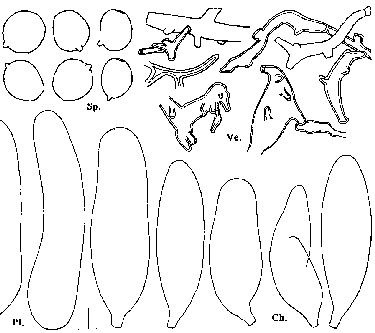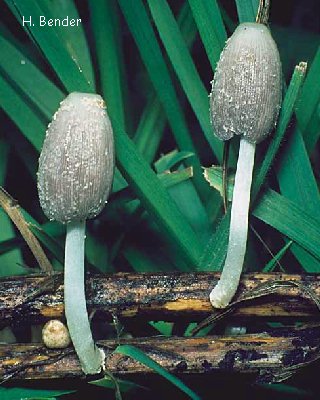Macroscopic features |
Pileus 5-15(-20) x 3-12 mm when still closed, subglobose, ellipsoid, oval or conical, up to 30 mm when expanded, white with ochre-brown, velvety scales, especially around disk. Lamellae, L = 32-38, l = 0-3, crowded, free, first white, then dark grey to blackish. Stipe up to 120 x 0.5-2 mm, white, greyish white, almost glabrous. |
Microscopic features |
Spores [140,7,6] 5.5-8.0 x 4.7-7.0 x 4.4-6.1 µm, subglobose or ovoid, sometimes slightly the shape of a maize-kernel, often truncate, dark red-brown, not strongly but distinctly lentiform with slightly to rather strongly eccentric, sometimes central, c. 1.0-1.3 µm wide germ pore; Q = 1.03-1.30, av. Q = 1.08-1.19; av. L = 6.1-7.1, av. B = 5.3-6.3 µm. Basidia 14-28 x 7-9 µm, 4-spored, surrounded by 4-7 pseudoparaphyses. Pleurocystidia 50-100(-150) x 10-30 µm, oblong, (sub)cylindrical or subutriform. Cheilocystidia 30-100(-120) x 10-30 µm, oblong, utriform or subcylindrical. Elements of veil thick-walled, strongly multiple-branched and diverticulate, 2-10 µm wide; walls less than 1.5 µm thick, pale yellow-brown. Clamp-connections present. |
Habitat & distribution |
In small groups on herbs and grasses. Rather common and widespread in Europe. |
Remarks |
Type-studies have shown that Coprinus saichiae is very similar in all macro- and microscopical characters to C. phaeosporus, so they are considered synonymous. |

[Copyright © by ]

[Copyright © by Hans Bender jbe8995374@aol.com]